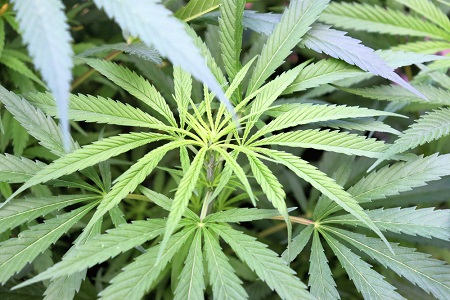
U.S., February 28, 2020 (420 INTEL)- Worried by widespread shortages of products at Illinois cannabis stores, medical marijuana patient David Kurfman took matters into his own hands. He started growing his own.
Having suffered from epilepsy most of his life, Kurfman uses medical cannabis to control his seizures without debilitating prescription drugs. But like many medical patients, Kurfman can’t take just any cannabis. He says he needs oils containing CBD, the cannabis component that prevents seizures, in a 2-to-1 ratio with THC, the part that gets users high.
Under the new state law, medical marijuana patients may grow up to five plants each at home. Kurfman said he spent $5,000 to build a deluxe grow room in the basement of his downstate home, outfitting it with lights, fans and separate compartments. He now tends a small garden of thriving, 3-foot high plants.
David Kurfman works with marijuana seedlings in his basement grow room. (Brian Cassella / Chicago Tribune)
“There’s a statewide shortage of all products, and patients are suffering from that,” Kurfman said. “I hope to transition to growing my own medicine.”
Kurfman is part of a community of medical cannabis users who have started making their own medicine in response to the shortages. They’re part of a small but decades-old underground movement of home growers that is coming out of the shadows now that it’s been legalized in Illinois.
The new law allows medical cannabis patients 21 and over to grow up to five plants in an “enclosed, locked space.” The growing space must be in a residential building with sleeping quarters and indoor plumbing, or a greenhouse or shed on the site, as long as it’s out of public view. Landlords may still ban growing pot on their property.
The patient may keep any amount produced by the plant, as long as it’s secured in the home where it was grown, but it remains illegal to sell or give away cannabis from one’s plants. Lawmakers originally proposed letting all adults grow pot for recreational use, but that provision was deleted after police and commercial growers raised objections. Most other states that have legalized recreational marijuana do allow the public to grow at home.
David Kurfman transplants seedlings to bigger pots at his home in Mount Sterling, Illinois. (Brian Cassella / Chicago Tribune)
In Illinois, law provides for patients to buy their seeds from licensed dispensaries. But patients say dispensaries are not selling seeds, and licensed cultivators say they don’t grow seeds because they sap energy from the buds, and are considered waste that would have to be cleaned out of the final product. Instead, professional growers generally use female plants generated from small cuttings from mother plants, known as clones. Home growers may use clones as well, once they have their plants established, but generally must start with seeds.
The law legalizing medical pot, which saw sales begin in 2015, never specified where commercial cultivators were to get their original seeds or plants, and federal law prohibits transporting seeds or plants across state lines. That left growers to perform a so-called unexplained immaculate conception as to how they started their crops.
Now home growers are faced with a similar situation. Most resort to buying from any of the many seed banks found online. Though buying marijuana seeds and growing them remains a violation of federal law, the amounts are so small and hard to detect that police rarely go after home growers unless they are manufacturing large amounts to deal it illegally, as has happened frequently in other states, such as California and Colorado.
To address the impasse, Gov. J.B. Pritzker’s administration is developing rules for seed sales.
“The administration is working with various state agencies, cultivators and dispensaries to develop a clear process that will allow the sale of seeds to medicinal users,” spokeswoman Charity Greene wrote in an email.
David Kurfman cuts clones from a bigger plant in his basement grow room. (Brian Cassella / Chicago Tribune)
For now, growers are educating each other online, through groups such as the Illinois Medical Cannabis Review Guide, which lists recommended seed banks.
Getting started can cost next to nothing, if one has free access to plants or seeds and a greenhouse. But growers say that the average indoor growing operation can cost hundreds of dollars, and requires five to 10 hours of work a week.
Cultivators and online sources, such as Fremont College or Leafly, describe growing plants to maturity as generally taking three to six months. Each seed grows through four distinct stages, from germination to seedling, vegetative and flowering. Each stage is an opportunity to enhance or screw up the process.
Basic equipment includes a clean, dry, dark space such as a closet, basement or a mylar growing tent, sort of a portable closet, where plants can be separated to be given the proper care at each stage.
To sprout seeds, growers often keep them in a wet paper towel or other container to keep the seed moist for a day or a week, until it grows roots and its first tiny leaves. The seedling must be planted in soil or compost, or grown hydroponically by feeding water and nutrients through a soil-less medium, such as coconut fiber or perlite, to develop for two to four weeks.
The law allows five plants of more than 5 inches tall, which growers interpret to mean they may grow numerous small seedlings and then select the best among them.
Next comes the vegetation stage, when the plant grows foliage under 18 or more hours of light a day, for two to eight weeks. Finally comes the flowering stage, lasting four to 12 weeks, when the light is cut back to 12 hours a day, similar to late summer, and the plant grows the buds that produce cannabinoids such as THC and CBD.
But the plant isn’t ready to consume yet. It generally takes another month or two of drying and curing before it’s at its best. The whole process can take four to six months, so it requires patience.
Last year, shortages of medical pot began to occur in Illinois in the run-up to recreational sales. Kurfman built his own growing room in the basement of his home in downstate Mount Sterling. He recently finished his first crop, and maintains it’s better than what he buys at the stores.
Most of his costs went into a pair of $1,500 full spectrum commercial grade, 645 watt LED lights, another $1,000 or so for construction materials, plus gardening materials.
It’s been said that if you can grow tomatoes you can grow weed, but growers says that’s not a fair comparison, because marijuana changes so much at each stage. It requires different amounts of nutrients, light and water at each stage, and must be transplanted to progressively bigger containers to make sure its roots are being watered but allowed to drain and dry to avoid root rot.
In its final flowering stage, cannabis requires extensive trimming of leaves, so perhaps a more apt comparison is to a bonsai tree.
The plants also generally need a fan and a duct to vent out hot air, and a carbon filter to remove the skunky smell that can seriously bother housemates and neighbors.
Kurfman followed the advice of two experienced mentors, and is proud of the finished product, saying, “It turned out magnificent.”
Other growers use more modest methods. Janelle Rinehart, a dispensary worker in Chicago, is raising two plants in a closet in her home in Irving Park, using hydroponics.
She calls her plants Elsa and Anna, and plays music by Lizzo and Sister Nancy to keep them energized. Eventually, she plans to slow-cook her pot in order to make cannabutter for cooking.
If grown well, one plant can produce a pound of pot — far more than the one ounce of flower that recreational users may possess legally, or the 2.5-ounce every two weeks purchase limit for medical patients.
David Kurfman displays the results of his first successful harvest in his basement grow room. (Brian Cassella / Chicago Tribune)
Many novices learn through trial and error. Those interested in getting guidance on how to grow pot at home may learn from Home Grow Chicago, which offers classes in raising small-scale cannabis crops. Managers Will Ikeda and Tommy Gliszewski started the business to share their love for cultivation.
Ikeda cautions that growers can run into numerous problems from lack of proper soil or nutrients for the plant, overwatering and underwatering, control of light, temperature (which should be in the 70s) and humidity (ranging from about 70% for a seedling to 40% in the final stages).
“We want people to understand how difficult this can be,” Ikeda said. “A lot of issues can arrive, triggered by the environment or inexperience. We want people to be aware of the pitfalls, so they don’t waste their time and money.”
Members of NORML, the national organization that pushed for years to legalize pot, still hope to make it legal for everyone to grow.
Mickey Nulf, a cultivator and patient in Illinois, thinks it will eventually become common for medical patients to grow their own medicine. To serve that market, Nulf produces the Prof. Budz Potcast, and hosts a Facebook page where he offers advice on cultivation. He considers it the most exciting and therapeutic part of legalization.
“Let’s put the power back into patients’ hands,” he posted, “and let’s take care of our community.”
 Investment value finders Investment value finders
Investment value finders Investment value finders



